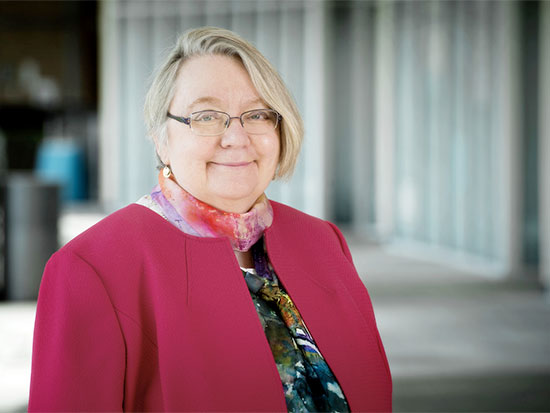 Pam Benoit, Ph.D.Pam Benoit, Ph.D., UAB’s new Provost and Senior Vice President for Academic Affairs, knows how to make a persuasive argument. The Indiana native was a debater in high school and college. For more than 25 years, she taught courses on topics such as persuasive speaking, interpersonal communication and communication theory at Miami University (Ohio), Bowling Green State University, the University of Missouri and Ohio University, while steadily advancing through the faculty and administrative ranks to full professor, department chair, dean and finally Executive Vice President and Provost at Ohio University.
Pam Benoit, Ph.D.Pam Benoit, Ph.D., UAB’s new Provost and Senior Vice President for Academic Affairs, knows how to make a persuasive argument. The Indiana native was a debater in high school and college. For more than 25 years, she taught courses on topics such as persuasive speaking, interpersonal communication and communication theory at Miami University (Ohio), Bowling Green State University, the University of Missouri and Ohio University, while steadily advancing through the faculty and administrative ranks to full professor, department chair, dean and finally Executive Vice President and Provost at Ohio University.
These powers of persuasion helped Benoit play a leading role at Ohio University, which has six campuses and more than 43,000 students. She was known as a top fundraiser and advocate for higher education with the state’s legislators. But as she explains in her book “Persuasive Messages: The Process of Influence” (2008, Blackwell) — written with her husband William Benoit, Ph.D., who joins UAB as a professor in the Department of Communication Studies — one of the most important steps in effective communication is to get to know your audience.
“Understanding the culture”
So Benoit, who joined UAB July 1, plans to devote her first months on the job to visits with school- and department-level groups across campus. “It’s clear that this is a special institution that is very much on an upward trajectory,” Benoit says. “That’s why I was interested in this position. But it’s also clear that I need to listen. I’m interested in understanding the culture of UAB, and what people perceive the issues to be, on campus as well as in the community.”
As the university’s chief academic officer, Benoit’s role is to “work with the deans to ensure that our academic enterprise is functioning at the highest possible level,” she explains. “Are we offering the kinds of programs that students want and need for success in today’s workforce, and getting the kinds of experiences in the classroom and lab that they should be getting?”
| As the university’s chief academic officer, Benoit’s role is to “work with the deans to ensure that our academic enterprise is functioning at the highest possible level,” she explains. “Are we offering the kinds of programs that students want and need for success in today’s workforce, and getting the kinds of experiences in the classroom and lab that they should be getting?” |
Answering these questions is crucial to the university’s overall strategic direction. Benoit will have an important voice in several ongoing campus initiatives, including a comprehensive strategic planning process, the introduction of a new budget model and implementing changes as a result of UAB’s Campus Engagement Survey.
“Incentivizing innovation”
As provost at Ohio University, Benoit played a leadership role in similar initiatives. She facilitated the development and implementation of OU’s Innovation Strategy, a bold plan to invest in cross-disciplinary challenges that tapped into the strengths of the university’s faculty.
“A lot of interesting work right now is being done at the intersections between disciplines,” Benoit says. “Finding ways to bring people together is crucial, but we in higher education are so oriented to departments and schools and colleges. So how do you make sure there are opportunities to work across boundaries?”
One of the strategies that proved successful at Ohio University was the idea of “incentivizing innovation,” says Benoit. “We put substantial grant money on the table” — ultimately, approximately $1 million apiece for four cross-cutting projects.
Money alone isn’t a solution, Benoit adds. “It takes time and effort,” she says. “Many people had not worked in teams before; we put together workshops and other infrastructure to help.” The results are worth it, Benoit says. “One of the projects was looking at developing new ways to measure bone strength and susceptibility to fracture,” she says. “They put together a team with faculty from engineering, medicine, biological sciences and more. They ended up building a device inspired by technology originally used in engineering to measure vibration in bridges.” The team got venture capital funding, and now the device is moving toward the marketplace. “When you can find new ways to bring faculty together, they do amazing things,” Benoit says.
Say that again?
Outside of work, Benoit has a great interest in the arts. Her sister is a professional artist; Benoit also has a passion for painting. Several of her works are displayed at Ohio University and one of its sister universities in Japan. She says she is looking forward to exploring Birmingham’s vibrant art scene.
Her other passion is reading. Benoit is a voracious consumer of books on higher education. (At her first meeting with the UAB Deans’ Council in late July, she announced that the group would spend the next months reading a book on the topic, and carve out time for discussion at each meeting.) “Then for fun I love to read mysteries,” she says. “I want to see if I can figure it out before the end of the book.”
One mystery that perplexes Alabamians: how do you say that last name? Although the influence of our Louisiana neighbors leads many to believe it is Ben-wa, it is actually pronounced Ben-oyt. “But it doesn’t matter how you say it,” she says. “I’m interested in hearing from all faculty — about their work and what’s on their minds. I’m really excited to be here.”